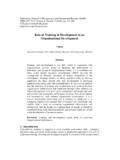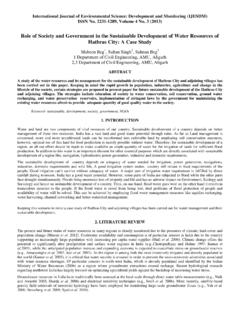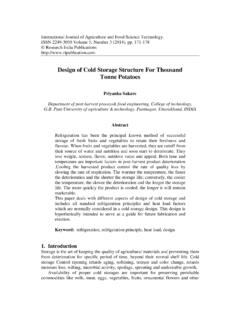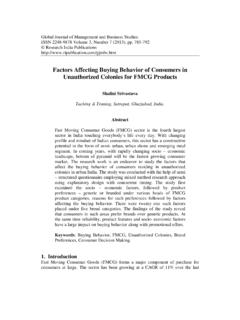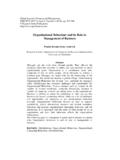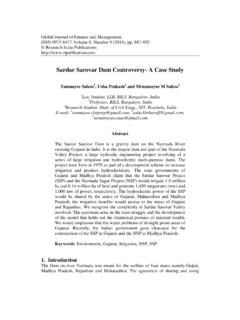Transcription of Extraction of Caffeine from Coffee and preparation of ...
1 Extraction of Caffeine from Coffee and preparation of Anacin drug Ms. R. R. Shinde Student, Department of Chemical Engineering, , Warananagar, Shivaji University, Kolhapur, Maharashtra, India Prof. N. H. Shinde Assistant Professor, Department of Chemical Engineering, , Warananagar, Shivaji University, Kolhapur, Maharashtra, India Abstract This paper focuses upon Extraction of a natural product, Caffeine , from Coffee . It has been chosen since the starting ingredients are relatively easy to come by, and we will still find a reasonable level of challenge. Caffeine is a natural product found in Coffee and tea. Efficient Extraction of Caffeine from Coffee relies heavily on the properties of Caffeine & other components present in Coffee . This work will focus upon procedure (Batch) for Caffeine Extraction and their working principles, its design aspect, various analytical methods for its separation/detection.
2 It is to be noted that its scale up can be done according to industrial demand for its usage for manufacturing other products. By using Caffeine as raw material, we will prepare an Anacin a pharmaceutical product which has several medicinal uses. Keywords Caffeine , Extraction , Coffee , physical Extraction , anacin, decaffeination Introduction Coffee has been enjoyed in the world for the past four thousand or so years and within the west for about the past 400 years. Coffee originated in China and this was the sole producer until the British Empire colonized India and began large Coffee plantations. This Coffee colonization spread too many other countries and had huge worldwide socio-political ramifications. Coffee drinking is still a very important ritual in Japan and England from the choreographed Japanese Coffee ceremony to the daily Coffee time held in homes and offices all across the Brazil.
3 Currently the Brazil is the highest consumer of Coffee in the world. Coffee is one of the most traded commodities, and is one of the most popular drinks in the world due to its unique flavor and sensory characteristics. Coffee beans are an important source of Caffeine , which is the most common consumed alkaloid in the world. Second to oil in terms of world commodity trading. Two major species of Coffee grown commercially are Robusta and Arabica. Arabica Coffee contains half the Caffeine of Robusta Coffee , at about 1-2% on a dry weight basis. The high consumption of Caffeine is argued to have created health hazards such as aggravating heart disease and high blood pressure Caffeine is a member of the class of compounds organic chemists call alkaloids. Alkaloids are nitrogen containing basic compounds that are found in plants. They usually taste bitter and often are physiologically active in humans.
4 Caffeine is a commonly encountered mild stimulant and a diuretic; it is widely used in proprietary drugs for the stimulant effect to prevent drowsiness. Caffeine is naturally present in the fruit and bark of a number of plants, including Coffee and coco. The amount of Caffeine in Coffee varies by brand but the average in common brands is typically about 30-40 mg Caffeine / Coffee bag. Caffeine is a naturally occurring substance found in the leaves, seeds or fruits of more than 63 plants species world wide. The most common sources of Caffeine are Coffee , cocoa beans, cola nuts, Coffee leaves, yerba mate, guarana berries and the Yaupon Holly. Caffeine is the most widely consumed psychoactive substance and can be a mild central nervous system stimulant. Caffeine is found in a number of things ingested by people. Caffeine acts as a stimulant. It stimulates the heart, respiration, the central nervous system, and is a diuretic.
5 Its use can cause nervousness, insomnia and headaches. It is physically addictive. The Caffeine so extracted can be further converted into items that we enjoy in our everyday lives - sodas, cosmetics & pharmaceutical products. Diet pills and cosmetic companies are the largest consumers of Caffeine . It can also be used in manufacturing body wash, soap, lip-balm, facial scrub and several other products such as Caffeine lipstick Caffeine can be extracted from cocoa by various methods, such as water Extraction , supercritical carbon dioxide Extraction and organic solvent Extraction . Solvents such as Chloroform, Methyl Chloride, Ethanol, Acetone and Ethyl acetate are commonly used for the solvent Extraction of Caffeine . Several methods can be used for this Extraction purpose, for example Soxhlet Extraction , Ultrasonic Extraction , and Heat Reflux Extraction .
6 The Heat Reflux Extraction is one of the common methods used to extract Caffeine from cocoa seed on a laboratory scale. Extraction is a technique in which a solvent is used to remove/isolate a compound of interest from a liquid substance. For example, Coffee is a liquid which contains dissolved Caffeine . The Extraction will be carried out by simply adding a portion of solvent to the Coffee . The Caffeine is more soluble in the solvent than in the Coffee , so it moves out of the Coffee and into the solvent. The solvent, now containing dissolved Caffeine , is then separated from the Coffee . If the solvent is allowed to evaporate or is removed in some manner, the Caffeine will be left behind as a white powder. International Journal of Engineering Research and Technology. ISSN 0974-3154 Volume 10, Number 1 (2017) International Research Publication House 236 Industrial applications of Caffeine The Caffeine so extracted can be further converted into items that we enjoy in our everyday lives - sodas, cosmetics & pharmaceutical products.
7 Diet pills and cosmetic companies are the largest consumers of Caffeine . It can also be used in manufacturing body wash, soap, lip-balm, facial scrub and several other products such as Caffeine lipstick. It is also used with painkillers for simple headaches and preventing and treating headaches after epidural anesthesia. Caffeine is also used for weight loss and type 2 diabetes. Caffeine creams are applied to the skin to reduce redness and itching in dermatitis. Solvent selection: Although water is almost always one of the liquids in the liquid-liquid Extraction process, the choice of organic solvent is quite wide. A good Extraction solvent needs five essential features: 1) Be immiscible with the other solvent (usually water). 2) Has a relatively low boiling point so as to be easily removed from the compound after Extraction . 3) Extract little or none of the impurities and other compounds present in the mixture.
8 4) Be nontoxic, non-reactive, readily available and inexpensive. 5) Has high solubility for the organic compound Table 1. Various methods of Caffeine Extraction Decaffeination Methods Description % Extraction 1 Water Non- toxic, complex process, remove little flavoring components 94-96% 2 Ethyl Acetate Removes Caffeine and little flavor compounds. Mildly toxic, removes some flavoring compounds. 96-98% 3 Dichloromethane Removes Caffeine and little flavor compounds. Highly toxic, removes some flavoring compounds. 94-96% 4 Supercritical CO2 Selectively removes Caffeine and very little flavor compounds, expensive 96-98% 5 Acetone Removes Caffeine and little flavor compounds, mildly toxic 96-98% Various decaffeination methods such as Swiss water process, Chemical solvent process, Supercritical carbon dioxide process are commercially used. The Swiss Water process used to be very popular as it does not require chemicals and retained more flavor components.
9 This has been replaced by the chemical solvent process that requires the use of methylene chloride/ethyl acetate. These solvents are considered toxic and hazardous, their presence in the product and their effect on the environment and operators need to be monitored carefully. Supercritical carbon dioxide uses very high pressure may take the natural taste of the product by extracting the hydrophilic components of the Coffee beans. Table 2. Commonly used solvents in Extraction are as below: Solvent Solubility in Water Boiling point (C) Density (g/ml) Ethyl Acetate Fairly soluble 76 Acetone Fairly soluble 56 Experimental method for Caffeine Extraction : 1) Take the Coffee beans and crush as small as possible 2) After crushing collect the powder form of Coffee 3) Put the required amount of Coffee powder into Soxhlet apparatus 4) Add the required amount of solvent either Acetone or Ethyl acetate into the Soxhlet apparatus.
10 5) Start heater for heating purpose and maintain the temperature 6) After prescribe time, collect the mixture and filtrate it by using filter paper for separating the solid content. 7) Put the liquid mixture into simple distillation apparatus for recover the solvent, so collect sample put into polyethylene bottle. 8) Finally samples are carried for analysis in GC Capillary column 9) Caffeine can further be gotten into powder form by putting the solution into the sublimator assembly as shown below: Fig. 1 Sublimator assembly International Journal of Engineering Research and Technology. ISSN 0974-3154 Volume 10, Number 1 (2017) International Research Publication House 237 Experimental set-up Fig. 2 Experimental Set-up Confirmative Test for Caffeine Detection Murexide test can be carried out for Caffeine detection as follows: 1. In a watch glass, small amount of a sample with 2-3 drops of concentrated hydrochloric acid is mixed.
